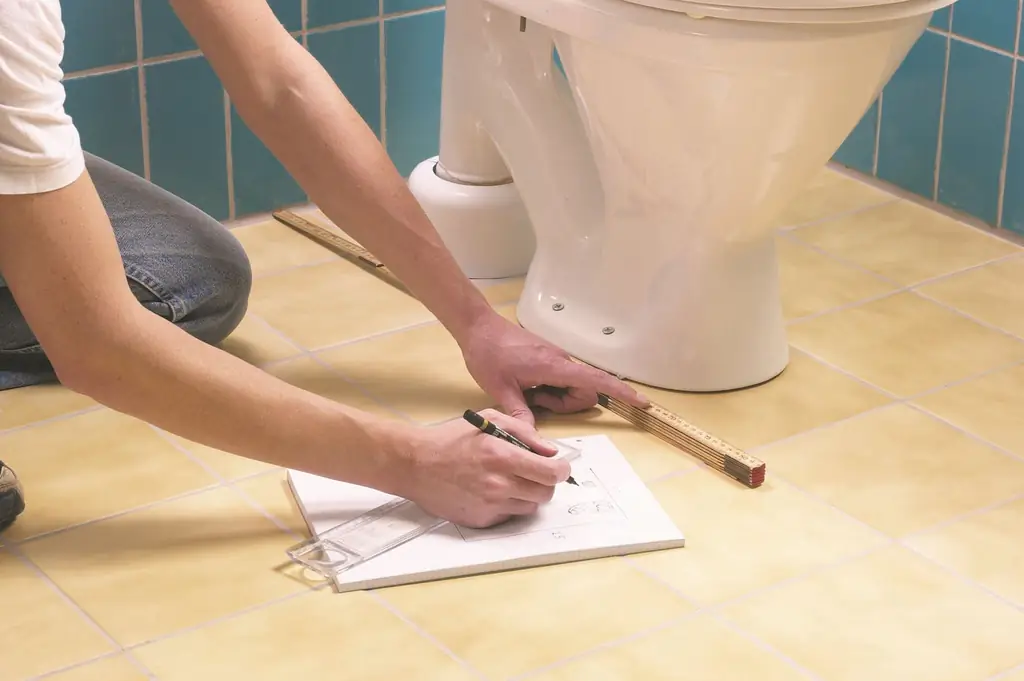
Table of contents:
- Your own plumber: we install the toilet ourselves
- The first thing to decide is which toilet to choose
- Dismantling the old toilet
- Do-it-yourself toilet installation process
- How to properly install the toilet, taking into account any little things
- What other options are there for installing a toilet?
- DIY video about installing toilet bowls
- Author Bailey Albertson [email protected].
- Public 2023-12-17 12:53.
- Last modified 2025-01-23 12:41.
Your own plumber: we install the toilet ourselves

If you have started a major overhaul of the bathroom, or the plumbing is out of order, then you may need to replace the toilet. This process has a number of features that must be taken into account, and the approach to choosing a new toilet should also be correct.
Of course, you can call a plumber from the housing office, or contact private craftsmen who will provide a professional installation. But installing a toilet with your own hands will not only save your money, but also allow you to understand the whole process, and therefore choose the most suitable installation option.
In this article, we'll walk you through everything you need to repair your toilet to help you do all the work yourself.
Content
- 1 The first thing to decide is which toilet to choose
- 2 Dismantle the old toilet
- 3 The process of installing a toilet with your own hands
- 4 How to properly install the toilet, taking into account any little things
- 5 What other options are there for installing a toilet?
- 6 Video about installing toilets with your own hands
The first thing to decide is which toilet to choose
Complete toilet replacement is part of a comprehensive overhaul, therefore it includes:
- selection of a new toilet, taking into account the methods of fastening and drainage;
- dismantling the old toilet;
- repair of the toilet room, including the replacement of pipes, screeds, cladding and other things;
- installation and connection of a new toilet.
You should buy a new toilet in advance, and at the same time you need to consider some features that will help you make the right choice.

Floor standing toilets are divided into several types according to their design. Their differences are based on the shape of the main nodes.
- The shape of the outlet can be horizontal, vertical or oblique, at an angle of 45 degrees.
- The bowl of the toilet can be visor, dish-shaped, or funnel-shaped.
- The models also differ in the type of cistern: it can be combined with the base of the toilet or mounted on the wall, and at different heights.
- The fixing of the toilet to the floor differs. It can be an option with two or four anchoring points, or a design in which the toilet is installed on special corners attached to the floor.
The method of connecting the tank will determine the types of further cladding work in the toilet room. For example, if you chose to mount to a wall, then you will need a prepared place and an anchor for installation.
Before replacing the toilet, calculate the dimensions of the bathroom, especially the combined one: the installed structure should not prevent the door from closing, and in addition, the installation of the rest of the equipment may be necessary.
Dismantling the old toilet
The instructions for installing the toilet should be followed exactly, so dismantling work will require care and following the recommendations. Step by step, this process is as follows.

- First of all, the water supply to the inside of the drain tank is shut off, water is drained from it and the underwater hose is unscrewed. After that, the tank fasteners are unscrewed. If they are rusted or covered with lime deposits, you need to hold the bolt head with a screwdriver and unscrew the nut with an adjustable wrench. Use kerosene or aerosol lubricant - these products will significantly soften rust and lime deposits.
- After the tank is removed, unscrew the fasteners that hold the toilet bowl - dowels or nuts screwed onto the anchor.
- Now you need to disconnect the drain from the sewer pipe. If your house is still old construction, then most likely the drain will be fixed with cement coating. In this case, you will need a hammer and chisel. Place the chisel across the grout and gently chuck the cement in two places. Rock the toilet with force so that the drain twists and looses. Tilt the toilet without disconnecting to drain any remaining water.
- After the dismantling of the toilet is finished, close the opening of the sewer pipe with a wooden stopper or a cloth stopper.
Dismantling the toilet does not require special care, because you are unlikely to reuse the product. Therefore, in case the cement paste is too strong, you can beat off part of the toilet with a sledgehammer to facilitate the work, and then make a transverse hole in the pipe, insert a metal rod there as a lever to make it easier to loosen the drain.
Do-it-yourself toilet installation process
After you dismantled the old toilet or completed all the finishing work, prepare the surface, level it and proceed with the installation of the toilet installation.

- Attach a rigid pipe or a corrugated pipe to the toilet bowl drain for articulation with the drainage pipe. The best option would be in which the toilet bowl drain enters the pipe outlet directly. When doing this, use a rubber gasket with a border. Do not seal the drain into the sewer inlet with cement.
- Prepare the water inlet. A flexible hose is well suited for this, which is screwed onto the inlet to the tank and the water supply tap. Pay particular attention to the diameter of the hose fittings at both ends.
- After the connection is made, you can fix the toilet on the wall or floor. We'll look at this process in more detail below.
- Assemble the toilet. Place the tank on the previously fixed base. If your tank is suspended, fix it to the wall and run the pipe. Now you can check how correct the tank settings are and how the toilet is working. Turn on cold water, wait until the tank is full. While the water is being collected, you can adjust its level. You can find out more about this from the instructions for the tank.
- The last step is to attach the toilet seat. There are holes on the top of the toilet bowl for attaching it, and the kit includes the necessary parts.
Now we will consider in more detail the ways of attaching the toilet, as well as the features of each of them.
How to properly install the toilet, taking into account any little things
Usually, there are three options with which the toilet is attached to the floor:
- installation with anchors cast in a screed or dowel;
- fixing the toilet bowl with screws on a wooden base, previously installed in the screed;
- installation on epoxy resin.
If you decide to change the toilet due to a major overhaul, then an anchorage or a prepared wooden base will be the most suitable option. In this case, the anchors for attaching the toilet are placed on the floor when the screed is formed. They should be installed so that they protrude 5-6 cm above the surface. Excess can then be cut off.

Match the taffeta (wood plank) to the size of the toilet base. Drive nails along the entire surface in a checkerboard pattern so that they protrude from the other side. Now flip the taffeta over and place it where the toilet will be. Pour the screed with concrete along the top edge of the board, install the toilet and secure it carefully with screws.
There are also certain rules for attaching a toilet bowl to a tiled surface. Be sure to wear rubber gaskets under the nuts and on the dowels: they will prevent the toilet bowl from cracking when tightened and prevent rusty streaks on the ceramics. Use nickel-plated anchors and bolts, they are easy to unscrew even after the service life has expired.
Tip: when installing the toilet on a tile covering, in order to prevent damage to its appearance, use an epoxy resin mount or dowels.
Under the dowels, you need to make holes through the screed and tile into which the screws will be screwed. The holes should not be too deep so as not to touch the waterproofing layer. If the screed is too thin, pour some sealant into the hole before installing the dowel. Be sure to put a rubber gasket on the screw. It is best to place the toilet on a sealant cushion and then press down with screws.
What other options are there for installing a toilet?
When installing a toilet, you can do without parts such as anchors, dowels and screws altogether. Epoxy resin will come to your aid. The main thing is to prepare the base of the toilet bowl and the floor surface according to all the rules. This option is optimal if the tank is mounted on a wall, since it represents half the weight of the entire structure.
- To get started, walk with sandpaper or an abrasive stone on the floor surface so that later the epoxy resin will set and hold well.
- Apply the adhesive to the floor and base of the toilet in an even layer of a few millimeters. Install the structure, level it and wait until the resin is completely dry.
Hanging toilets have become popular lately. They are installed on the wall without any contact with the floor. For installation, you need to make a metal frame and attach it to the load-bearing wall, and fix the toilet directly on it if you plan to hide the pipes and the tank behind a drywall wall.

It is also possible to mount a suspended toilet with an open cistern directly to the wall, but in this case, you will need to transfer the sewer pipe into the wall. Fastening of the structure is carried out by using anchors built into the frame or wall.
DIY video about installing toilet bowls
Having familiarized yourself with the process of self-assembly of the toilet, you can easily determine how much money you have managed to save without involving a plumber or a private craftsman. We are always happy to help you in any endeavors. In the comments, you can leave your questions, comments and examples from your own experience. Comfort for your home!
Recommended:
Do-it-yourself Chimney Cleaning Using Potato Peelings, A Chainsaw And Other Methods, Including Folk, Instructions With A Video

You can maintain the chimney in the house yourself without resorting to the services of specialists. We will tell you how to clean the chimney with your own hands
How To Independently Insulate Windows For The Winter, Various Methods, Tips, Recommendations (with Video)

Practical advice on self-insulation for the winter of wooden and plastic windows. Materials and tools used
Various Ways To Restore An Old Cast-iron Bathtub, Self-restoration Of Enamel, Practical Advice + Video

Practical advice for restoring an old cast iron bathtub. Required materials and tools. Ways to repair and restore bath enamel
How To Remove Iodine From Clothes And Other Surfaces, Than To Wash It From The Skin, Various Methods And Means + Video And Photo

How to remove iodine from different fabrics, wash stains from furniture, body and other surfaces. Effective ways with instructions for use with photos and videos
How To Lay The Laminate Yourself: The Necessary Tools, Methods, Installation Technology And Rules + Video

Practical recommendations for laying laminate flooring. Styling technology and methods. Materials and tools used
